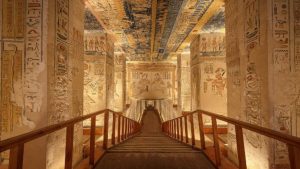During the Renaissance, architecture stood out profoundly in innovation and iconic structures. The revival of ancient Roman and Greek architecture, classical principles and humanism were the central characteristics of this period. Domes, symmetrical designs, the revival of the arch are some salient features of this innovation. Iconic structures like Brunelleschi’s dome in Florence Cathedral and Palladio’s Villa Rotonda showcased mastery in proportion and harmony.

The Renaissance marked a great manifestation of change in ideas and ideals. Art and architecture were held superior and remarkable contributions have been made through creative ways and innovative ideas. The fine arts of this period were an embodiment of the historical antecedents, the intellectual, moral, and material conditions and the religious beliefs of the people. The development of the individual man was one of the key characteristics of the Renaissance. Artistic productions of this time are distinctly individual or personal stamps. This is especially marked in architecture.
The uniqueness of Renaissance architecture
The architecture of the Renaissance was an expression of the personal tastes of individuals working independently of each other. The architects of this time who were also scholars and artists, acquainted with the Roman antique, animated with a desire to appreciate what they apprehended of its principles and to achieve personal fame was their ambition. A building of the Renaissance was always the product of the fancy of a particular designer. The architecture of the Renaissance though marked the glory of an individual, it was always a collective venture of many minds and the natural expression of many conditions.
Nearly all of the architects of this epoch were sculptors and painters. Formal training in architecture was never a reality and hardly any of them were endowed with a natural aptitude for logical construction. The architecture of the Renaissance became a mere surface architecture differing fundamentally from all the great architectural systems of ancient times, and of the Middle Ages.
Some important key figures of the era:
One of the key figures in Renaissance architecture was Flippo Brunelleschi who manifested his ingenuity in groundbreaking work in Florence’s Cathedral. Brunelleschi’s well renowned achievement was the design and construction of the dome of the Florence Cathedral or Santa Maria Del Fiore. The dome, a triumphant engineering which was completed in 1436, was the largest of its kind. Brunelleschi used innovative construction techniques such as a double shell structure and herringbone brick pattern.
Another iconic figure in Renaissance architecture was Andrea Palladio. Palladio’s work influenced beyond his native Italy to become a guiding force for architects across Europe. ‘The Four Books of Architecture’, an architectural treatise, outlined his design principles and contributed to the dissemination of classical ideas. His works portrayed symmetry, proportion, and classical elements such as columns and pediments. The Villa Rotonda, one of Palladio’s master pieces is an exemplification of his principles.
The hallmark of Renaissance architecture was the revival of classical elements. Architects drew inspiration from ancient Roman and Greek structures, incorporating features like columns, arches, and domes into their designs. Architectural design was also the result of advancements in perspective, driven by artists like Leon Battista Alberti. The application of linear perspective allowed architects to create more realistic and harmonious spatial compositions. The buildings were designed with a sense of depth and proportion, contributing to a visually pleasing and balanced aesthetic. Renaissance architects also embraced the concept of humanism, placing a greater emphasis on the individual.
The history of architecture makes a special mention of Renaissance architecture and innovations. Figures like Flippo Brunelleschi and Andrea Palladio spearheaded these changes, introducing novel construction techniques and design principles. Three important aspects; the revival of classical elements, advancements in perspective, and a humanistic approach collectively defined Renaissance architecture. It has influenced the domain of architecture for the future as well.
ARTICLE BY – WILLIAM SANTOSH | EDITED BY – SAHIL HARVANI



